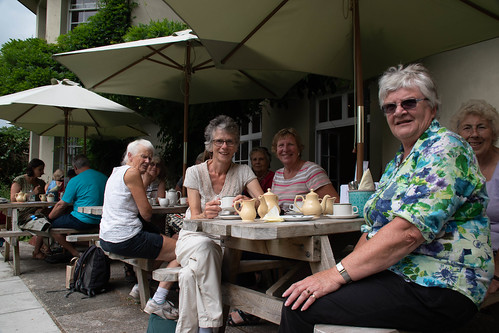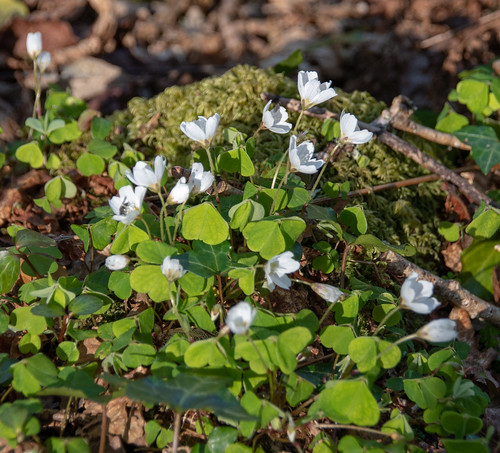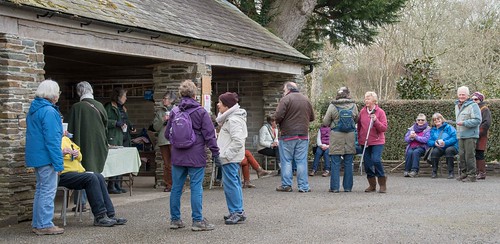Update 18th December 2018 Unfortunately, today's visit to the Trellissick Garden Illuminations had to be cancelled due to the stormy and wet weather. Update of 13th October 2018 Unfortunately, today's visit Andrew's Corner and Stone Lanes Gardens had to be cancelled due to the stormy and wet weather. We will reschedule for next year. Update of 18th September 2018 Report on Garden Visit of 17th September 2018 Pinetum Gardens, St Austell Only six members of the group made their way to The Pinetum Gardens on this drizzly Monday. The weather was dull when we arrived for our visit to these extensive gardens but we had a cheery welcome from an assortment of entertaining ducks and then the owner Chang Li to fire our enthusiasm. We hadn't visited since the days when Ray and Shirley Clemo lived there. It was apparent that Chang greatly admired Shirley, reminding us she planted over six thousand plants and trees and was awarded an MBE for services to horticulture. By the time we started the visit, the weather had dried up and as there was no wind, it turned out to be a perfect morning for garden visiting. There are six separate gardens each original in style and planting, a deciduous and coniferous arboretum and walks though natural woodland, two ponds and a lake. Throughout there are discoveries to be made - signs with poems and philosophical thoughts, also many sculptures in stone, wood and metal. Even an old school bell which was heard to ring while we were there! Chang has also thoughtfully placed many benches, some under cover or in summerhouses. There is so much to see here they were much appreciated. To round off this lovely visit we had a nice lunch in their cafe. We achieved a first for Lostwithiel U3A with no-one ordering any of their lovely cakes! Do we get a medal? Update of 24th August 2018 Report on Garden Visit of 21st August 2018 John Mann's Garden in Higher Truscott Higher Truscott is acharming hamlet set high on a hill above Launceston. It was here that 16 membersof our group gathered to be shown around the garden belonging to John and GillyMann. Developed over a periodof over 40 years from the yard and orchard of an old farmhouse, the area to therear of the house was designed by John who took his inspiration from Trebah Gardenand tried to re-create the look of a valley. What catches your eye first are the rockeriesfilled with a huge variety of alpine plants; your eyes are then drawn to the narrowlawn area surrounded by shrubs and trees. The collection of trees and shrubs includedifferent variety of sorbus, a Swedish maple, a Chinese acer, a bush snowdrop. Gradually the moreformal garden morphs into a ‘woodland area’ of Viburnums, Acers, Magnoliasincluding fine M. proctoriana, which in Spring is underplanted with white fritillariasand a large Magnolia stellata which came from the original Treseder’s Nurseryin Truro. There are also numerous helleboresand this would be a great garden to visit again in the Spring. You cross the lane and youare in the second part of the garden which used to have a swimming pool. That area has been transformed into a Rill Garden Feature and John’s inspiration came from the Gardens& Grounds of Herstmonceux Castle inSomerset. This part of the gardenincludes a productive vegetable garden and we tasted an unusual variety of cucumbercalled “cucumber crystal lemon” in the shape of a small tennis ball - the tastewas very refreshing. John showed us inone of the greenhouses how he was growing succulents in tufa rock. What is memorable inthis part of the garden is the amazing view that you get from the wooden bandstand: you first see the old part of Launceston withits old houses nestling around the castle and then you have a 180 degree viewof Dartmoor. All gardeners have facedmany challenges this year: the wetAutumn, Winter and Spring, the two spells of Beast from the East in March andthen the very hot and dry Summer. Despite all those challenges, the garden was an absolute treat with manyplants, shrubs and trees in bloom, including: white and pinks cyclamens, floweringa month early; delicate specimens of buddleia and gladiolas which none of ushas seen before; Eucryphia; Senecio; Eucomis (Pineapple flower and pineapplelily); Itea; Calycanthus; Campsis; delicate geraniums; many salvias and fuchsias;deep red broad-leaved plantain and dark leaved small sedums. John Mann loves troughs.We saw: An old cider trough turned into a pond containing water lilies Belfast sinks coveredin concrete - you would think they wereold troughs. After tea and biscuits,we left truly inspired by our very knowledgeable hosts who, in their eighties,not only manage this large garden on their own but also keep planning futureprojects. Update of 19th July 2018 Report on Garden visitof Friday 13th July 2018 Wildside and TheGarden House
Eleven ofus spent an absolutely glorious day visiting those two spectacular gardens inBuckland Monachorum.
It is notoften that I am lost for words when producing a report but I have to say thatthe visit to Wildside is giving me a challenge: how to describe adequately the creativity, originality and beauty ofthis wild garden which amazed us all. Thequote on the Wildside website summarises eloquently what the Wileys aimed toachieve: On the wild side - an experiment in new naturalism "Looking at thetreasure trove of gardening ideas to be found in nature, from under our nosesto far-flung corners of the globe. By allowing our observations of naturallandscapes to inform our plantings, I believe that we can loosen thestrait-jacket that long-established horticultural practices impose allowing theenormous creative potential, latent within most of us, the freedom to expressitself." Wildside garden and nursery on the edge of Dartmoor was created by KeithWiley where he lives with his artist wife Ros Wiley. Keith Wiley was head gardener/manager at TheGarden House, a 10-acre garden on the edge of Dartmoor in the southwest ofEngland, between 1978-2003, where he created what has been described bynational commentators as 'one of the most exciting and innovative gardens inBritain today' and the best example of 'leading-edge horticulture” in this country. The gardenhe has created at Wildside can be loosely described as naturalistic in stylebut Keith has taken this to whole new level. The garden was originally a flatfield but he has transformed the site through extensive landscaping andspectacular planting. The planting was inspired by Keith and Ros' travelsaround the world and then recreating elements of these wild landscapes in hisown garden, from wildflowers in Crete to meadows in South Africa and beyond. Ineffect he has recreated the natural habitats of plants from all over the worldin his own garden which required a huge amount of landscaping, digging deepravines and valleys and piling up large hills and banks of soil. Then, plantshave been given just the right location, aspect, soil type and amount of lightor shade. The other benefit of such colossal landscaping has been the varietyof viewpoints created, from up high on a steep bank looking down or from thebottom of a ravine looking up. There are so many plants at Wildside and of suchvariety, it is hard to believe and yet they grow side by side happily as onebig community.
 Afternoon visit to The Garden House This gardenis entirely funded by the work of a small charity “The Fortescue GardenTrust”. We had visited the Garden Housein September 2017 and had been so impressed by its beauty that we had decidedthat it would be worth returning to the garden sometime in the summer when theherbaceous borders would be at their best. We were not disappointed. This inspirational garden blends seamlessly into atimeless Devon landscape, and offers stunning views in all directions. Theeight acre garden is really several gardens in one, using over 6,000 varietiesof plants to great effect in both traditional and naturalistic planting styles. In the summermonths, at the heart of this magical place is the walled garden, designed andplanted by Lionel Fortescue and his wife Katherine in the mid-1940s. 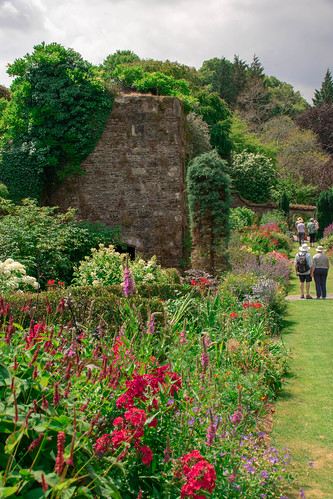 Brooding over all is the ruin of thevicarage tower: the vicarage tower was replaced in the 19th century by what isnow the Garden House, where the visitors can enjoy morning coffee, lightlunches and afternoon teas in a beautiful mansion. Some of us indulged in both a Garden Houselunch and afternoon refreshments! Click on image above to launch a slide show with more photos. Note: Slide show may not work with all devices. Same photos available via this flickr page. There is also an exotic South African Garden, as well asthe romantic Cottage Garden and Wild Flower Meadow. Later, in autumn, a glade of Japanese maplesprovides a kaleidoscope of autumnal colour. A new two-acre arboretum has recently beenplanted to celebrate the Golden Jubilee of the Fortescue Garden Trust. Some of us are already planning our next visit to the garden,maybe in January/February to admire their collection of snowdrops: Matt Bishop, thehead gardener is considered a world authority on them.
Update 7th June 2018 Report on visit to Anvil Cottage and Windmills of 6th June2108 We were able to kick the winter wardrobe into touchfor this visit and T-shirts, suntan lotion, sunhats and even shorts were the orderof the day! After a mystery tour of the lovely but narrow Cornishlanes and their hedges full of wild spring flowers, seventeen members of thegroup arrived at their destination in South Hill for a 2.00pm start. At Anvil Cottage, we were greeted by GeoffClemerson on his own, as his wife Barbara was having physiotherapy having twistedher leg whilst taking a group round earlier in the week. Anvil Cottage One member of the group aptly summarised the gardenas “a garden of surprises”. Anvil Cottage is a plantsman’sgarden. Winding paths take you through aseries of themed rooms housing both familiar and unusual plants. We liked so manyof the plants, shrubs and trees that we discovered during our visit:
Thegarden was full of mauve Primulas Candelabra, white flowering Astrantias and manyvarieties of very fragrant roses. Some of the rambling roses along with very healthylooking clematis are climbing though shrubs and trees creating a splash ofcolour where you least expected it. We noticed that some of the bamboos were inbloom and we learned that sadly that means that they are likely to die. We marvelled at the fact that, despite thegarden being so high up, the banana trees and the bougainvillea had survived the“Beast from the East”. Higher up,a wild flower garden with a profusion of ragged robin leads through a formalrose garden. The rose garden was replanted this year, as many of the rose busheswhich looked an absolute picture this time last year had been severely damagedby the winter’s winds. From the rose garden, you walk toa raised viewpoint with a bench from which you can admire the spectacular viewsof Caradon Hill and Bodmin Moor. I amnot sure that Geoff and Barbara spend much time sitting on their well-positionedbench watching the sunset and sipping wine!
Windmills We did not meet the owners of Windmills as they were away on holiday butthey had kindly given us permission to walk round. Whereas Geoff and Barbara has started their gardenfrom scratch with the use of diggers to clear out a garden that had beenneglected for years, their neighbours had inherited a well-establishedgarden. Their pride and joy is their vegetableplot and rightly so. Everything lookedso healthy and well ahead of any of our own gardens. We also marvelled at the fact, in both properties, the sweet peas are wellestablished and in bloom, whereas several of us lamented the fact that in ourrespective gardens, the young plants appear to be on a “go slow” mode! Barbara came back just in time to help Geoff serve tea and cake. As we left, there was an opportunity to say goodbye to the fairies who have a meeting place by the gate of Anvil Cottage. Update 11th May 2018 Reporton visit to Moyclare of 9th May 2018 After a scorching hot MayBank Holiday, it was a case of delving back into the winter wardrobe for the 10members who visited Moyclare in Liskeard, a visit organised by Sue Luttmer. It was everybody’s first visit to this gardendespite it being so close to Lostwithiel and despite its reputation: it was once the most televised garden inCornwall. The owner was very generouswith her time and took us for a guided visit of the garden. We are glad she did, as she was able to pointout some of the rare trees and plants it contains and told us about their history. We would have missed much if we had walkedround on our own. Moira and Louis Reid bought theplot of land. The garden was planted in1927 and extended in 1936. Moyclare is nowowned by their niece Elizabeth Henslowe and her husband Philip. This one acre garden is full of mature trees,shrubs and tiny treasures, some from Ireland and some from the SouthernHemisphere, some rare and unusual and some more familiar. We learnedthat about 50% of the plants in the Lanhydrock Garden come from Moyclare. Every part of the garden hasa name e.g. “Moira’s border, “Quartz Island”,“Tanglewood”, “Spike Island”, "TorchwoodGarden" and storyboards tell the story of the garden through anecdotes of itshistory, successes and disasters and hopes for the future. There was so much to take inand I am not sure that the summary below will do it justice!
And of course, we finishedour visit with refreshments. A cup of teawas most welcome at the end of our one and a half hour tour: the weather had stayeddry and we were all getting rather cold. Roll on Summer! Update 23rd April 2018 Report on visit to Lanhydrock of Thursday 19th April 2018 Spring, or even Summer had arrived for the Garden Visits Group Guided Estate Tour, of just a small part of Lanhydrock. It was in 1953 that the National Trust purchased the 200 acre estate and our first point of interest was the outdoor swimming pool, situated only a few minutes walk from the domed reception, and used in the Victorian era by the Gentry of the House. Despite the glorious weather, sadly no one was tempted to take a dip in the murky water! 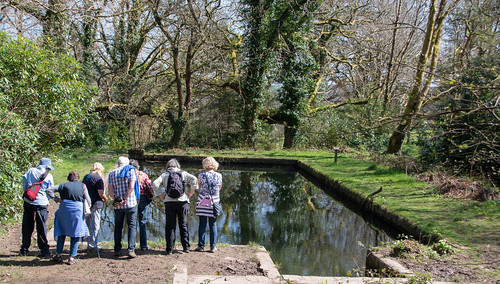 Our guide Chris, had a wealth of knowledge - told us about the 13 varieties of Bats on the Estate, the 184 types of lichen and took us along to see the 600 yrs old Oak Tree - there was a much younger Oak close by - a mere 400 yrs old.  The wild flowers were just stunning and a few early bluebells were spotted by some observant members. We also found a tiny pale yellow wild flower with a clover type leaf which no one was able to identify - anyone out there able to help? Our tour ended with all twelve members sitting outside the Stable Cafe, enjoying tea and cakes. Click on image above to launch a slide show with more photos. Note: Slide show may not work with all devices. Same photos available via this flickr page. Photo Credit: All photos by Lindsay Southgate ************************************* Report on visit of Tuesday 20th March 2018 to Ince Castle 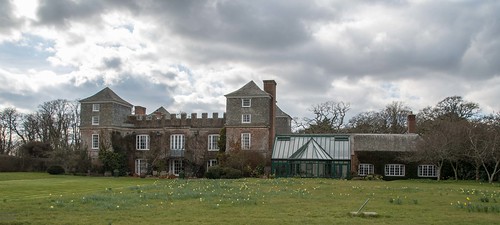 Nineteen U3 members joined by twelve members of theWhitecross and District Gardening Clubmade their way to Ince near Saltash on the first day of Spring. As we drove into the property, we weregreeted by a profusion of primroses and daffodils that grow either side of thelong drive  Lady Boyd greeted us and gave us an introductory talk aboutthe garden. Her mother-in-law, Patricia, Viscountess Boydnée Guiness bought Ince Castle in 1960. The present garden is almost entirely the design of Patricia, Lady Boyd,who was a very keen plantswoman and a vice president of the Cornwall GardenSociety. She made the formal garden onthe south side of the house soon after moving there and the shell house wasbuilt in 1963. Since moving to the house in 1994, the presentLord Boyd and his wife have flattened the lawn to the east of the house to improvethe view of the river from the ground floor room and placed at the entrance of theforecourt the stone lions which were made to go on the Admiralty at the end ofthe Mall in London. They also build theconservatory and the tennis court and removed the tarmac from the entrancefront.  The snow that had fallen at the week-end had melted away butas that had been the second blast of the “Beast from the East” in three weeks,we knew that the garden might not be in its best condition. Of course some of the camelia flowers hadbeen damaged by the frost but the garden was as delightful as it was last year whentwo members of the group visited for the first time. We were each provided with a map and this ensuredthat we did not miss any of the many features of the garden. In the spring, the areas of the garden at theirbest are the snowdrop wood (snowdrops and cyclamens), the woodland garden (camelliasand later on bluebells) and the spinney (daffodils, primroses, wood anemones, hyacinthsand hellebores). We were particularly impressedby the hellebores which grow on a wall in the spinney. In all seasons, a visit to the shell house and to theBathing Pool by the river Lynher is a must. Spend some time on the seat at the top at the Bowling Green as it gives you a good view towards theriver. This is one of the things that makeInce Castle such a special garden to visit: the views of the river Lynher and of the Devon countryside as far asDartmoor. Click on image above for enlarged view  We enjoyed our customary tea and cake at the end of thevisit with Lady Boyd available to answer any of our questions. Sadly Ince Castle came on the market that veryday. If the new owners do not open thegarden to the public as part of charities days or to groups like ours, we will beone of the last groups ever to visit the gardens. What luck! Click on image above to launch a slide show with more photos. Note: Slide show may not work with all devices. Same photos available via this flickr page. Photo Credit: All photos by Lindsay Southgate ************************** 13th February 2018 update We had a very fruitful planning meeting on Tuesday 23rd January (and a very pleasant lunch) and I take this opportunity to thank the 21 members of our group who met to produce a very detailed third draft of our 2018 programme of visits. I also thank those members who did much research prior to our meeting. I e-mailed/sent all members a document which I have put together following our meeting. It contains much information and this will hopefully enable everybody to make informed decisions as to which gardens they would like to visit. I have updated the grid below but I have not included all the details, as it would have looked too cumbersome. Do not hesitate to contact me or the visit organisers for fuller details. ******************************************************** Visitto Pencarrow House on Sunday 11th February  Nine hardy members of the GardenVisits Group met at Pencarrow House on Sunday afternoon on February 11th tovisit the gardens and in particular, to see the snowdrops on the first of 'ThePencarrow Snowdrop Sundays', when the gardens are open to show the snowdrops attheir best and the entrance is by donation for a particular charity. Itwas in aid of the dog charity Last Chance Hotel on the 11th and next week,February 18th it will be for Blood Bikes, who carry vital supplies of bloodwhere it's needed in an emergency. We arrived in glorious sunshine,which continued for most of the afternoon apart from a sudden shower of hailwhich took us all by surprise. Despite the sun it was very cold and in placesquite windy, but that did not dampen our enthusiasm.  Click on image above for larger view The car park and house are at thebottom of a drive approx 1 mile long. Once parked you walk upwards towards thehouse, with parkland to the left and woods to the right of the drive. We weregiven a plan of the gardens with the areas of snowdrop planting highlighted.There are paths throughout and snowdrops could be seen from them but there werelots of clumps around the base of treesand scatterings around the grass which merited a closer look. We followed thepath to the top of the lake, noticing signs of Spring on the foliage of trees.There was a Salix with beautiful furry buds just appearing, which emphasisedthe name Pussy Willow by which most of us know it. There were also camellias invarious stages of flowering, some still with tight buds, others in full flower.We had to retrace our steps as the path going back around the lake was rathersteep and muddy. We cut across into the Italian garden in front of the housewhich has a beautiful circular lawn with a wide gravel path and planted withspring bulbs in flower beds at the side. We followed the path where we sawcrocuses and narcissi along with more snowdrops. There was an area in the woodshighlighted on the plan with more snowdrops but we were just too cold to gofurther, so sought out the tea room and had a warming drink.  ****************************************************** |
Garden Visits >

